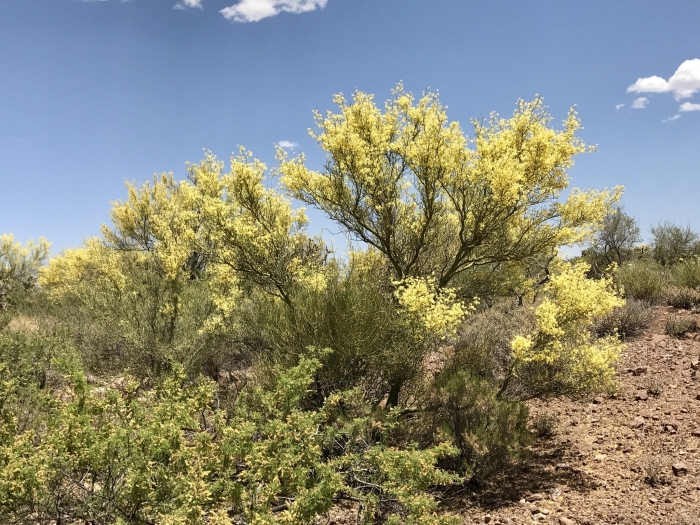Yellow Paloverde
(Parkinsonia microphylla)
Yellow Paloverde (Parkinsonia microphylla)
/
/

CK Kelly
CC BY 4.0
Image By:
CK Kelly
Recorded By:
Copyright:
CC BY 4.0
Copyright Notice:
Photo by: CK Kelly | License Type: CC BY 4.0 | License URL: http://creativecommons.org/licenses/by/4.0/ | Rights Holder: CK Kelly | Publisher: iNaturalist | Date Created: 2017-05-05T18:09:24Z |






















































Estimated Native Range
Summary
Parkinsonia microphylla, commonly known as Yellow Paloverde, is a deciduous tree or large shrub native to the Sonoran and Mojave Deserts. This species is adapted to arid environments, often found in desert washes, mesas, and rocky hillsides where it forms part of the scrub community. It is a slow-growing species, sometimes living for several hundred years, and typically reaches heights of around 5 meters (16 ft). The Yellow Paloverde has a bristling, upright-branching habit with a sparse canopy. Its leaves are small, yellowish-green, and drought-deciduous, meaning the tree will shed them during dry periods to conserve water. Remarkably, it can perform photosynthesis in its green bark, allowing it to survive without leaves during hotter periods. The flowers are small, pale yellow, and appear at the end of branches in late spring, creating a showy display when conditions are favorable. The tree may not flower every year, with blooming dependent on rainfall. Following sufficient rain, it produces 4–8 cm long, soft pods that dip between each seed, ripening in July and adhering to the branches.
Yellow Paloverde is valued for its drought tolerance and is often used in xeriscaping, modernist, and native plant gardens, as well as in parking lot plantings for commercial developments. Its ability to thrive with minimal water makes it suitable for low-water-use landscapes. The tree prefers full sun and can tolerate a range of soil types, provided they have good drainage. Seedlings are highly drought-sensitive for the first two to three months, with only about 1.6% survival rate post-germination. Gardeners should be aware that while the tree is generally low-maintenance, it may require supplemental water during establishment and extreme drought.CC BY-SA 4.0
Yellow Paloverde is valued for its drought tolerance and is often used in xeriscaping, modernist, and native plant gardens, as well as in parking lot plantings for commercial developments. Its ability to thrive with minimal water makes it suitable for low-water-use landscapes. The tree prefers full sun and can tolerate a range of soil types, provided they have good drainage. Seedlings are highly drought-sensitive for the first two to three months, with only about 1.6% survival rate post-germination. Gardeners should be aware that while the tree is generally low-maintenance, it may require supplemental water during establishment and extreme drought.CC BY-SA 4.0
Plant Description
- Plant Type: Shrub, Tree
- Height: 12-20 feet
- Width: 12-25 feet
- Growth Rate: Slow
- Flower Color: Yellow
- Flowering Season: Spring
- Leaf Retention: Deciduous
Growth Requirements
- Sun: Full Sun
- Water: Low
- Drainage: Fast, Medium
Common Uses
Bee Garden, Bird Garden, Butterfly Garden, Drought Tolerant, Fragrant, Hummingbird Garden, Low Maintenance, Street Planting
Natural Habitat
Sonoran and Mojave Deserts, desert washes, mesas, and rocky hillsides
Other Names
Common Names: Littleleaf Palo Verde , Foothill Paloverde , Little-Leaved Palo Verde
Scientific Names: Parkinsonia microphylla , Cercidium microphyllum , Cercidiopsis microphylla
GBIF Accepted Name: Parkinsonia microphylla Torr.